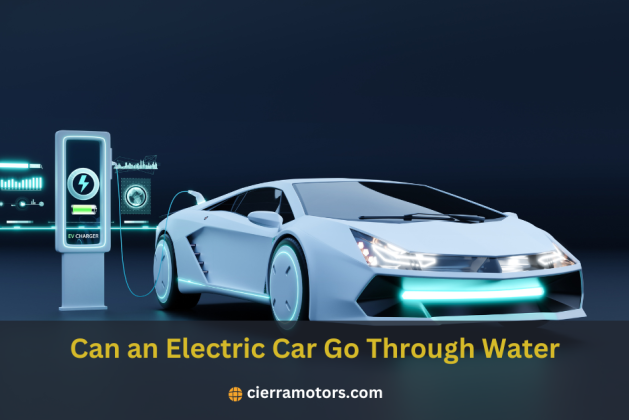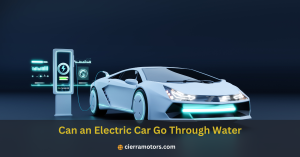Can an Electric Car Go Through Water?
The rise of electric vehicles (EVs) as a sustainable alternative to traditional petrol and diesel cars has prompted many questions about their capabilities, especially in challenging conditions. Among the most intriguing is whether an electric car can go through water. This question highlights concerns about safety and functionality and touches on the broader topic of EV reliability and the future of eco-conscious driving.
Understanding Electric Car Components
Electric cars are a whole new breed compared to traditional combustion-engine vehicles. Imagine cars powered purely by batteries and electric motors, sidestepping the intricate dance of parts found in internal combustion engines. This shift from complexity to simplicity is notisn’t just cool – it is a game-changer, especially when you think about how these futuristic vehicles deal with water.
Waterproofing in Electric Cars
Manufacturers understand the inherent risks when electricity comes into contact with water, which could lead to catastrophic failures or safety hazards. To mitigate these risks, they invest significantly in engineering solutions to waterproof the essential components of electric vehicles (EVs). This involves the meticulous sealing of the battery packs, which power the vehicle. The battery pack, the core power source of an EV, receives exceptional attention to ensure its integrity and functionality are not compromised by moisture or water ingress.
Furthermore, the electric motor converts electrical energy into mechanical energy to drive the vehicle, and the power electronics, which manage the flow of electrical energy within the vehicle, are also rigorously protected. Manufacturers employ advanced sealing technologies and materials to encase these components, safeguarding them against moisture. This includes using gaskets, sealants, and sometimes even encapsulation in waterproof casings.
This level of protection is designed to ensure that even if an EV is temporarily submerged in water, such as during heavy rains or in a flood scenario, the critical electrical components remain dry and operational. By doing so, manufacturers not only enhance the safety and reliability of electric vehicles but also help alleviate consumer concerns about the viability of EVs in all weather conditions. This waterproofing effort is a testament to the industry’s commitment to safety, innovation, and the long-term sustainability of electric mobility.
Can Electric Cars Go Through Water?
The capability of an electric car to traverse water depends on several factors, including the depth of the water and the vehicle’s specific design and engineering. Some modern EVs are adept at handling wet conditions, from driving through puddles to tackling flooded roads.
Real-World Examples
- Tesla Model S in Kazakhstan: A viral video showed a Model S swimming through a flooded tunnel, emerging unscathed on the other side. This unofficial ‘test’ certainly is not recommended, but it showcases the vehicle’s resilience.
- Nissan Leaf in the UK: Documented instances of the Nissan Leaf navigating flooded streets provide testimony to its watertight engineering.
- Renault Zoe in France: The Renault Zoe’s performance in heavy rain and flooded conditions highlights its robust design against water ingress.
- Chevy Bolt EV’s Water-Fording Capability: General Motors conducted tests to validate the Chevy Bolt’s capability to operate safely in specific water depths.
- An Electric Van in the Netherlands: During severe floods, an electric van proved its utility and durability by delivering goods even through significantly waterlogged streets.
Tips for Electric Car Owners
While some EVs can handle wet conditions impressively, it is crucial to practice caution:
- Avoid Deep Water: Always err on the side of caution and avoid driving through deep-standing water or floods.
- Regular Inspections: Ensure your EV’s seals and waterproofing measures are inspected regularly, especially before the rainy season.
- Know Your Car: Familiarize yourself with your EV’s specific features and limitations regarding water fording.
The Future of Electric Cars and Water
Ongoing research and development efforts are focusing on enhancing the waterproofing of EVs further, ensuring that electric cars can tackle more challenging conditions while maintaining safety and performance. Innovations in battery technology and vehicle design promise to make electric vehicles even more resilient in the future.
Conclusion
The assertion that electric cars can traverse water within certain limitations stands true for many modern models. These vehicles represent a convergence of eco-conscious driving and advanced technology, capable of meeting the challenges of various driving conditions. By understanding the capabilities and limitations of their electric vehicles, owners can confidently and safely enjoy the benefits of electric mobility.
FAQs
Q: Are electric cars safe to drive in the rain?
A: Yes, electric cars are designed to be weather-resistant and can operate safely in wet conditions. However, practicing caution and avoiding driving through deep water or floods is essential.
Q: Can an EV get damaged if submerged in water?
A: Like any vehicle, an electric car can sustain damage if submerged in water for an extended period. However, modern EVs are designed to withstand temporary submersion and operate safely in wet conditions.
Q: How does the waterproofing of electric cars compare to traditional combustion-engine vehicles?
A: While both vehicles have measures to protect against moisture intrusion, electric cars tend to have more robust sealing systems due to their reliance on electronic components and batteries. However, it is essential to note that all vehicles are vulnerable to water damage if submerged in deep water or floods for extended periods. Overall, electric cars have proven capable of handling wet conditions and continue to improve in this aspect, highlighting their potential as the future of sustainable driving.
Q: Are any risks associated with driving an electric car in wet conditions?
A: As with any vehicle, there are risks associated with driving an electric car in wet conditions. Practicing caution and avoiding deep water or flooded areas is crucial to prevent damage and maintain safety. Regular inspections of the vehicle’s waterproofing measures can also help mitigate potential risks. Understanding your EV’s specific features and limitations regarding water fording can also help ensure safe driving in wet conditions.




Leave a comment